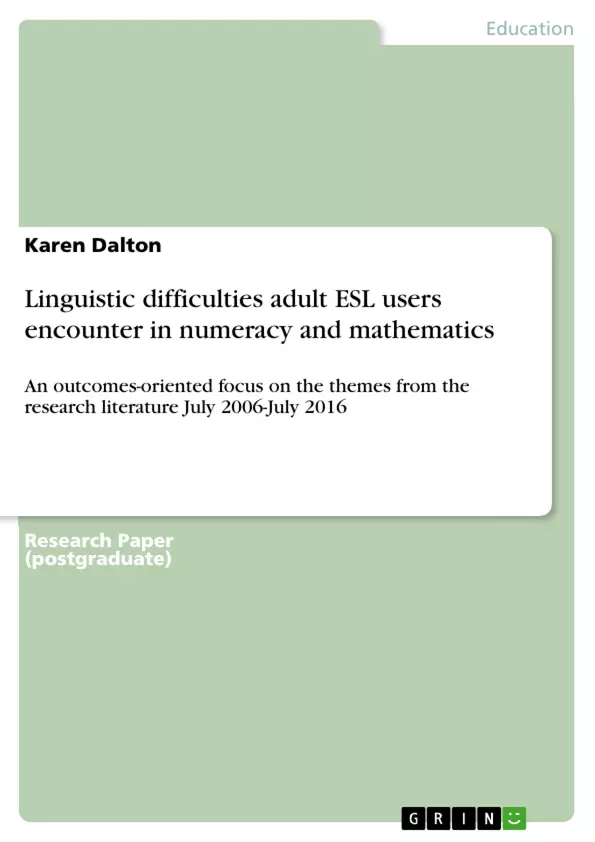This literature review undertook a purposeful sample of outcomes based research literature from the preceding decade that highlighted the language difficulties adult ESL users experienced while learning numeracy and mathematics. The most identifiable areas of research to emerge are policies and frameworks, pedagogy, educational programmes and educational resources. Whilst the request from the American Institute for Research to explore the linguistic challenges adult ESL users encounter in numeracy remains relatively unexplored; there is a growing collection of research papers emerging that contemplate linguistic difficulties in this area as a peripheral issue not a central one.
Inhaltsverzeichnis (Table of Contents)
- Abstract
- Research Prior to 2006
Zielsetzung und Themenschwerpunkte (Objectives and Key Themes)
This literature review examines research from 2006-2016 on the linguistic challenges adult ESL learners face in numeracy and mathematics. It aims to identify key areas of research and highlight the gap in existing literature regarding this specific population.
- Linguistic challenges faced by adult ESL learners in numeracy and mathematics
- The impact of language on mathematical learning and performance in adult ESL learners
- Existing research gaps and the need for further investigation
- Policy and framework implications for adult ESL numeracy education
- Pedagogical approaches and effective educational resources for adult ESL learners in mathematics.
Zusammenfassung der Kapitel (Chapter Summaries)
Abstract: This literature review analyzes research from the previous decade on the linguistic difficulties adult ESL (English as a Second Language) learners experience while learning numeracy and mathematics. The review focuses on research themes emerging from studies on policies and frameworks, pedagogy, educational programs, and resources. While acknowledging the relative lack of research directly addressing this specific challenge (as noted by the American Institute for Research), the review highlights a growing body of research that considers linguistic difficulties in numeracy as a peripheral rather than a central issue.
Research Prior to 2006: This section discusses the state of research prior to 2006, highlighting the uneven development of adult literacy and numeracy programs due to shifting government priorities, practitioner beliefs, and external influences. It contrasts numeracy and mathematics, noting the varying definitions depending on whether individual learner needs or economic imperatives are prioritized. The section critically examines the lack of acknowledgment by the American Institute of Research (2006) of pre-existing research on adult bilingual students learning numeracy and mathematics, including work from the 1970s in the UK and key developments leading to the 1991 Australian Language and Literacy Policy. The lack of research focused on this specific population is emphasized. Furthermore, the section highlights the importance of dialogue between learner and teacher for successful mathematical learning, a concept amplified by increased access to online learning resources.
Schlüsselwörter (Keywords)
Adult ESL learners, numeracy, mathematics, linguistic challenges, language difficulties, adult education, mathematics education, research gap, pedagogy, educational resources, policies, frameworks, bilingual education.
Frequently Asked Questions: A Literature Review on Linguistic Challenges Faced by Adult ESL Learners in Numeracy and Mathematics
What is the focus of this literature review?
This literature review examines research from 2006-2016 on the linguistic challenges adult ESL (English as a Second Language) learners face in numeracy and mathematics. It aims to identify key areas of research and highlight the gap in existing literature regarding this specific population.
What are the key themes explored in the review?
The review explores the linguistic challenges faced by adult ESL learners in numeracy and mathematics, the impact of language on mathematical learning and performance, existing research gaps, policy and framework implications for adult ESL numeracy education, and pedagogical approaches and effective educational resources for adult ESL learners in mathematics.
What does the review say about research prior to 2006?
The review discusses the uneven development of adult literacy and numeracy programs before 2006 due to shifting government priorities, practitioner beliefs, and external influences. It notes the varying definitions of numeracy and mathematics depending on whether individual learner needs or economic imperatives are prioritized. It also criticizes the lack of acknowledgment by the American Institute of Research (2006) of pre-existing research on adult bilingual students learning numeracy and mathematics.
What is the main finding regarding research on this topic?
The review highlights a relative lack of research directly addressing the linguistic challenges faced by adult ESL learners in numeracy and mathematics. While acknowledging this gap, it also points to a growing body of research that considers linguistic difficulties in numeracy as a peripheral rather than a central issue.
What are the key policy and framework implications discussed in the review?
The review examines the implications of research findings for policies and frameworks related to adult ESL numeracy education. This includes considering the impact of government priorities, practitioner beliefs, and external influences on program development.
What pedagogical approaches and resources are considered relevant?
The review explores pedagogical approaches and effective educational resources that can be used to support adult ESL learners in mathematics. The importance of dialogue between learner and teacher is emphasized, along with the potential benefits of increased access to online learning resources.
What are the key words associated with this literature review?
Adult ESL learners, numeracy, mathematics, linguistic challenges, language difficulties, adult education, mathematics education, research gap, pedagogy, educational resources, policies, frameworks, bilingual education.
What is included in the Table of Contents?
The table of contents includes an abstract and a section on research prior to 2006.
- Quote paper
- Karen Dalton (Author), 2016, Linguistic difficulties adult ESL users encounter in numeracy and mathematics, Munich, GRIN Verlag, https://www.grin.com/document/438704



